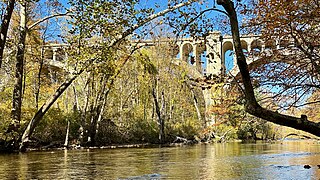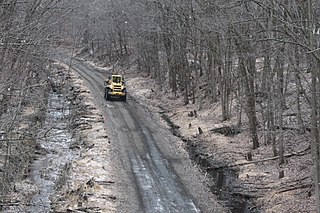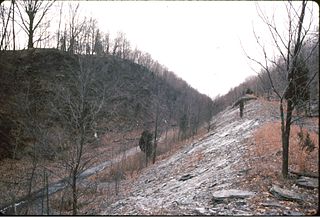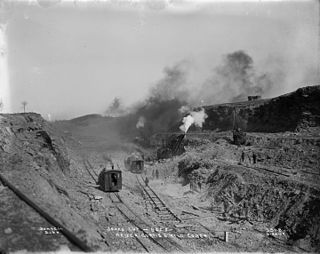
The Lackawanna Cut-Off was a rail line built by the Delaware, Lackawanna and Western Railroad (DL&W). Constructed from 1908 to 1911, the line was part of a 396-mile (637 km) main line between Hoboken, New Jersey, and Buffalo, New York. It ran west for 28.45 miles (45.79 km) from Port Morris Junction in Port Morris, New Jersey, near the south end of Lake Hopatcong about 45 miles (72 km) west-northwest of New York City, to Slateford Junction in Slateford, Pennsylvania near the Delaware Water Gap.

Lake Hopatcong is a commuter railroad station for New Jersey Transit. The station, located in the community of Landing in Roxbury Township, Morris County, New Jersey, United States, serves trains for the Montclair-Boonton Line and Morristown Line at peak hours and on holiday weekends. Service from Lake Hopatcong is provided to/from Hackettstown to New York Penn Station and Hoboken Terminal. The stop is located on the tracks below Landing Road next to the eponymous Lake Hopatcong. The station consists of one active platform with shelter, and an abandoned side platform. There is no accessibility for handicapped people.

The Paulinskill Viaduct, also known as the Hainesburg Viaduct, is a reinforced concrete railroad bridge that crosses the Paulins Kill in Knowlton Township, New Jersey. When completed in 1910, it was the largest reinforced concrete structure in the world.
The Boonton Branch refers to the railroad line in New Jersey that was completed in 1870 and ran 34 miles (54.8 km) from Hoboken to East Dover Junction as part of the Morris & Essex Railroad (M&E). Although the branch hosted commuter trains, the line was primarily built as a freight bypass line. The term "branch", therefore, is somewhat of a misnomer since the Boonton Branch was built to higher mainline standards than the Morristown Line, the line that it bypassed. As a result, the Boonton Branch better meets the definition of a "cut-off" rather than a branch. Some of the towns that the Boonton Branch passed through included Lyndhurst, Passaic, Clifton, Paterson, Wayne, Lincoln Park, Mountain Lakes, and its namesake, Boonton.

Slateford Junction was a railway junction in the small town of Slateford, Pennsylvania, that operated from 1911 to 1979.

The Erie Lackawanna MU Cars were a fleet of electric multiple unit commuter railcars used by the Delaware, Lackawanna and Western Railroad (D&LW) and successor railroads in the state of New Jersey. The D&LW undertook electrification of its Morristown Line and related branches in 1929–1930, and purchased 141 motor cars from Pullman to operate it. These were supplemented by 141 unpowered trailers of various types which were converted from existing rolling stock. The multiple units were successful and remained in service until 1984.

Port Morris Junction is the railroad connection between NJ Transit's Montclair-Boonton Line and the Lackawanna Cut-Off. Opened in 1911 by the Lackawanna Railroad, it is in the Port Morris, New Jersey section of Roxbury Township, New Jersey, south of Lake Hopatcong.

Roseville Tunnel is a 1,024-foot (312 m) two-track railroad tunnel on the Lackawanna Cut-Off in Byram Township, Sussex County, New Jersey. The tunnel is on a straight section of railroad between mileposts 51.6 and 51.8 (83 km), about 6 miles (9.7 km) north by northwest of Port Morris Junction. Operated for freight and passenger service from 1911 to 1979, it is undergoing work intended to return it to passenger service by 2026.

The Pequest Fill is a three-mile (4.8 km) railroad embankment in northwestern New Jersey completed in 1911 by the Delaware, Lackawanna and Western Railroad. Part of the Lackawanna Cut-Off, it was touted as the largest fill and the highest embankment ever built for a railroad.

McMickle Cut is the longest cut on the Lackawanna Cut-Off railroad line in northwest New Jersey. It was built between 1908 and 1911 by contractor Timothy Burke between mileposts 47.1 and 48.1 where Stanhope and Byram Township meet. Some 600,000 cubic yards of material was removed by dynamite and other methods to make the cut, which is 1.04 miles long, has an average depth of 29 feet, and a maximum depth of 54 feet.

Waltz & Reece Cut is the deepest cut on the Lackawanna Cut-Off railroad line in northwest New Jersey. The cut is 0.68 miles (1.09 km) long, has an average depth of 37 feet (11 m), and a maximum depth of 114 feet (35 m).

Lubber Run Fill is a fill on the Lackawanna Cut-Off railroad line in northwest New Jersey. Located between mileposts 50.1 and 50.5 in Byram Township, it was built between 1908 and 1911 by contractor Waltz & Reece Construction Company. It is 0.40 miles (0.64 km) long, has an average height of 64 feet, and a maximum height of 98 feet. Most of its 720,000 cubic yards (550500 m3) of fill material was excavated from the surrounding low-lying area.

Wharton Fill is one of a number of fills (embankments) on the Lackawanna Cut-Off railroad line in northwest New Jersey. Located between mileposts 51.1 and 51.6 in Byram Township, the fill was constructed between 1908 and 1911 by contractor David W. Flickwir. The fill, which was created by placing fill material obtained by blasting with dynamite or other methods, is about 0.5 miles (0.64 km) long. Most of the material that was used to create Wharton Fill was excavated from the surrounding low-lying area through which Pumpkin Run runs; several of the borrow pits have since flooded and become ponds.

Colby Cut is one of a number of cuts on the Lackawanna Cut-Off railroad line in northwest New Jersey. Located between approximately mileposts 51.8 and 52.3 in Byram Township, the cut was constructed between 1908 and 1911 by contractor David W. Flickwir. The cut, which was created by removing fill material obtained by blasting with dynamite or other methods, is 0.53 miles (0.85 km) long, has an average depth of 45 feet (14 m), and a maximum depth of 110 feet (34 m). The cut was the result of the removal of 462,342 cubic yards of fill material within this section.

Ramsey Fill is one of the fills (embankments) on the Lackawanna Cut-Off railroad line in northwest New Jersey. Located between miles 60.4 and 60.9 in Frelinghuysen Township, the fill was constructed between 1908 and 1911 by contractor Hyde, McFarlan & Burke. The .53-mile (0.85 km) fill has an average height of 21 feet, and a maximum height of 80 feet. It was created with 805,481 cubic yards (615,834 m3) of fill material obtained by blasting with dynamite or other methods.

Armstrong Cut is one of the largest cuts on the Lackawanna Cut-Off railroad line in northwest New Jersey. Located between approximately mileposts 61.4 and 62.3 in Frelinghuysen Township, the cut was constructed between 1908 and 1911 by contractor Hyde, McFarlan & Burke. The cut, which was created by removing fill material obtained by blasting with dynamite or other methods, is 0.89 miles (1.43 km) long, has an average depth of 52 feet (16 m), and a maximum depth of 104 feet (32 m). The fill was created as a result of the removal of 852,000 cubic yards of fill material from this section of the right-of-way. Armstrong Cut is located on a tangent (straight) section of track, permitting 80 mph (130 km/h).

Jones Cut is one of the cuts on the Lackawanna Cut-Off railroad line in northwest New Jersey.

Vail fill is one of the fills on the Lackawanna Cut-Off railroad line in northwest New Jersey. Located between approximately mileposts 65 and 65.3 in Blairstown Township, the fill was constructed between 1908 and 1911 by contractor Hyde, McFarlan & Burke. The fill, which was created by fill material obtained by blasting with dynamite or other methods, much of which was obtained from nearby Jones Cut, the fill is 0.32 miles (0.51 km) long, an average of 39 feet (12 m) high, and a maximum of 102 feet (31 m) tall. The fill contains a total of 293,500 cubic yards of material. Vail Fill is located on a 1° curved section of track, permitting 80 mph (130 km/h).

The Nicholson Cutoff is a rail line segment of the Sunbury Line rail line and formerly a rail line segment of the Delaware, Lackawanna and Western Railroad main line and the Delaware and Hudson Railway South Line. The Nicholson Cutoff and the rest of the Sunbury Line is owned by Norfolk Southern Railway.
The Waltz & Reece Construction Company was a construction company that operated in the first quarter of the 20th century, best known for its work on the Lackawanna Cut-off in New Jersey.

















